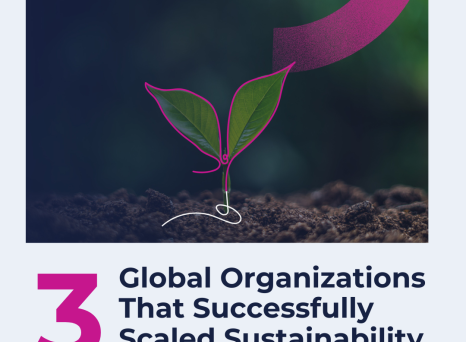What is the environmental impact of the materials you use? Do your distributors and suppliers promote safe and fair labor practices? What are your logistics providers doing to reduce their carbon footprint? When you’re evaluating the environmental, social, and governance (ESG) risks of your supply chain, these are just a handful of the questions you need to be able to answer.
Better ESG evaluation and performance is an urgent priority for today’s organizations. They take climate change seriously because they’ve seen the impact that phenomena like extreme weather and biodiversity loss have on their communities and their bottom line. Many also need to prepare for the effects of new legislation from the SEC and the European Commission. The upcoming regulation will require companies to provide even more detailed reports on the sustainability-related risks of their operations.
If you’re a supply chain leader looking to evaluate and improve ESG metrics across your supply chain, you’ll need to start with the right data. But, where do you find it and how can you improve it? This article will explore just that using Boston Consulting Group’s (BCG) six-step process for navigating ESG risks in supply chains as our guide.
Key ESG Data Sources for the Supply Chain
To evaluate your ESG performance effectively, you need to know what data you have and what to include. This follows the first 2 steps in the BCG process: create transparency and calculate risk scores. Start by examining the data you can obtain internally.
Scope 1 and Scope 2 carbon emissions are likely to be the first ESG data you think of and can be quickly evaluated with the help of online emissions calculators.
As a supply chain leader, you’ll also have access to resource utilization data. This includes factors such as:
- Resource allocation. Where you’re using your budget, materials and people.
- Workload distribution. How well the work is shared across teams.
- Infrastructure usage. How effectively and efficiently you use owned tech, office space and machinery (such as those used on production lines).
Next, you’ll want to dive into your supplier data. Improving your ESG metrics means examining your entire supply chain. The more complex the supply chain, the easier it is for ESG risks to slip through the cracks. So, visibility through data is key to identifying, mitigating, and managing ESG risks. This includes factors like your suppliers’:
- Labor practices. How their employees are treated and compensated.
- Water and energy consumption. How much they use and how they minimize or mitigate their usage levels.
- Health and safety measures and records. What steps they take to keep employees safe, including training and equipment, as well as their incident record.
- Carbon emissions. Your suppliers’ carbon emissions fall under Scope 3 emissions.
And finally, evaluate your historical project data. You can learn a lot from previous projects, whether you were implementing digital transformation or launching a new product. This includes a combination of qualitative and quantitative data:
- Waste. How many resources were wasted as a result of issues like inaccurate demand forecasting or supply planning—this includes budget, people, materials, end products, and energy.
- Post-project reviews. This could include the success rate of product rollouts or efficiency improvements following digital transformation.
- Compliance checks, audits, and certifications. Keep track of what you have completed and whether they need to be re-submitted, updated and so on.
Armed with this data, you are on the road to an actionable evaluation of your ESG performance. But if you want to achieve tangible improvements in your metrics, you’ll need more accurate and up-to-date data.
Improve The Accuracy of Your ESG Metrics
Now we have the data we need. But, with increasing scrutiny from regulators on the validity of ESG reports, data accuracy is key. This is where the next 2 steps of the BCG process come in: develop risk-specific measures and define new cornerstones. Here are some of the most effective ways to boost your ESG data accuracy.
Invest in your suppliers
If ESG is important to your business, it should be important to your suppliers too. However, different businesses have different processes, requirements, and priorities when it comes to ESG. Your suppliers may be doing everything right — but if they’re not recording, inputting or reporting that information somewhere you can access it, you’ll be left with gaps in your data.
Consider working with your suppliers to align your ESG goals. This could include encouraging suppliers to complete ESG-relevant certifications or helping them implement technology to track their ESG metrics. Collaboration is crucial for supply chain success. And even more crucial for data accuracy.
Integrate your systems with suppliers
BCG also recommends creating a center of excellence when it comes to navigating ESG risks. Not just for your team, but for your suppliers, too. If your organization has a project management office (PMO), this is an approach they would be familiar with and could support you in setting up. You could also consider investing in technologies that simplify and automate ESG measurement, centralize all ESG data across the supply chain, and enable everyone to see ESG risks in real-time. This will break down any silos, help avoid human error, and create a single source of truth between you and your suppliers.
Include ESG metrics in the bidding process
When embarking on a new project, consider implementing ESG assessments during the bidding process. This will ensure you and your providers are aligned from the beginning. And, it will save you valuable time when it comes to collating your ESG data.
It is important to remember that improving ESG is an ongoing investment (as the BCG’s sixth step of monitor, audit, and campaign highlights). So, consider implementing solutions or working with suppliers that monitor ESG risks over time. This data will help boost accuracy in the short and longer term.
Improved ESG Metrics - More Resilient Supply Chains
Connecting up your data sources, elevating your data quality and simplifying your analysis can create more accurate, impactful ESG reports for stakeholders. But, it can also reveal opportunities to make your supply chain more agile and resilient in the face of ever-shifting business priorities and external forces.
Digital PPM tools like Planisware can help supply chain leaders see ESG targets in tandem with operational and strategic business goals. PPM tools can provide greater visibility of resources, suppliers, and ESG performance. That way, supply chain leaders can quickly evaluate and take action to improve sustainability metrics. Supply chain leaders using PPM tools can benefit from:
- A centralized hub of supply chain data
- Real-time insight for the most up-to-date and accurate reports
- A complete view of ESG metrics and wider business goals
- End-to-end visibility of the product journey, from new product development through to rollout
- Compelling, visual reports that clearly demonstrate opportunities for sustainable improvements to stakeholders for sign-off or investment


